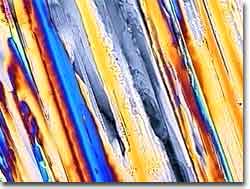Urea Movies

Urea Video No. 1 - Urea crystallization is observed under polarized light illumination at a magnification of 20x in this video. Playing time is 6.5 seconds. Choose a playback format that matches your connection speed: 28.8k (modem), 56.6k (modem), or T1/Cable/DSL, or download this video clip in MPEG format (2.72 MB).
Urea Video No. 2 - Urea crystallization is observed under polarized light illumination at a magnification of 20x in this video. Playing time is 9.8 seconds. Choose a playback format that matches your connection speed: 28.8k (modem), 56.6k (modem), or T1/Cable/DSL, or download this video clip in MPEG format (4.11 MB).
Urea Video No. 3 - Urea crystallization is observed under polarized light illumination at a magnification of 20x in this video. Playing time is 9.8 seconds. Choose a playback format that matches your connection speed: 28.8k (modem), 56.6k (modem), or T1/Cable/DSL, or download this video clip in MPEG format (2.13 MB).
Also called carbamide, urea is a colorless, crystalline compound. It is the chief nitrogenous end product resulting from the metabolic breakdown of proteins in all mammals and some fishes. Commercially, urea is used as a fertilizer and feed supplement and is a base material for the manufacture of plastics and drugs. Urea functions as a stabilizer in nitrocellulose explosives and is a constituent of synthetically prepared resins.
Urea occurs not only in the urine of all mammals but also in their blood, bile, milk, and perspiration. During protein metabolism, amino groups (NH2) are removed from the amino acids and converted to ammonia (NH3). Ammonia is toxic to the body and is converted to urea by the liver. The urea then passes to the kidneys and is eventually excreted in the urine. The compound was first isolated from urine in 1773 and synthesized in 1828.
